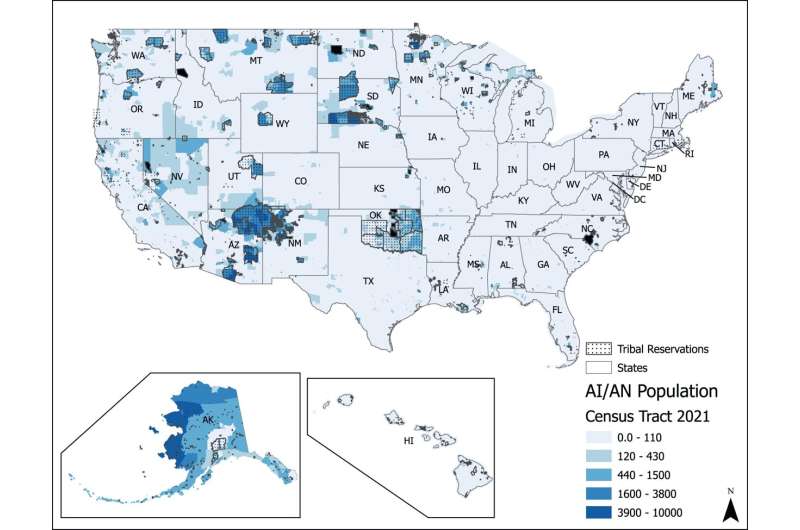This article has been reviewed according to Science X's editorial process and policies. Editors have highlighted the following attributes while ensuring the content's credibility:
fact-checked
proofread
US drinking water often contains toxic contaminants, scientist warns

Most Americans take it for granted that the water that comes out of their taps is clean and safe to drink.
But a new study published by a University of New Mexico scientist with colleagues from across the U.S. warns that water from many wells and community water systems contains unsafe levels of toxic contaminants, exposing millions to health risks, including cancer.
The review in the Journal of Exposure Science and Environmental Epidemiology also finds that people living on tribal lands or in minority communities are disproportionately affected and predicts that climate change will make it harder to locate safe sources of drinking water.
The paper emerged from a meeting of senior scientists at the annual meeting of the International Society for Exposure Epidemiology, said Johnnye Lewis, Ph.D., professor emerita in the Department of Pharmaceutical Sciences, multiple principal investigator of the Navajo Birth Cohort Study, co-director of Community Environmental Health Program and director of the UNM METALS Superfund Research Program.
"There were several of us that have expertise in dealing with these particular contaminants, and we were seeing that they're not always at safe levels in drinking water sources for a number of reasons," Lewis said.
The paper assesses seven known contaminants that often find their way into drinking water: arsenic, fracking fluids, lead, nitrates, chlorinated disinfection byproducts, manmade chemicals known as PFAS (per- and polyfluoroalkyl substances) and uranium. The ability to detect and remove these substances from drinking water varies widely.
Most of the substances, including inorganic arsenic, nitrates, uranium and lead, are known or suspected carcinogens, while chronic exposure to most of the contaminants has been linked to a host of other issues, including neurological and developmental problems.
"Some of these, like uranium and arsenic—and even nitrates—are just common," Lewis said. "They commonly occur in groundwater, and sometimes it is the source that you have access to."
Other contaminants, like fracking fluids and PFAS, are introduced by humans and represent uncharted risks.
For example, PFAS can linger in the environment for decades without degrading, a problem that hasn't been addressed until recently.
"I think there was concern, but it wasn't at this scale and was elevated to where it is now," Lewis said. "It's like much of what we do as a society. You take the action first and then down the road try to figure out how to fix it. That's usually a bad strategy."
The seven contaminants represent a small fraction of the thousands of the chemical agents present in drinking water, the authors report. To complicate matters, two or more contaminants may be present in a water source, presenting the possibility of synergistic effects.
"We're only really now starting to come up with good methods to assess what those mixtures do," Lewis said. "There's always a lot of uncertainty, because a mixture is not the same in one community as it is in the next."
Larger water systems have the ability to remove or dilute the concentrations of some contaminants, but many Americans lack even that minimal protection.
The researchers estimate that there are about 150,000 public water systems in the U.S., about one-third of which are community water systems serving about 320 million Americans—95% of the population. Ninety-one percent of the community water systems serve fewer than 10,000 people—covering 52 million in all, while more than 43 million Americans rely on private wells for drinking water.
The authors say their paper "highlights the need for a concerted effort to invest in upgrading our drinking water infrastructure, strengthen drinking water standards, develop and implement enhanced water treatment, collect and disseminate monitoring data, and require more stringent chemical safety testing."
Lewis meanwhile cautions that climate change is making it harder to find clean sources of drinking water, particularly in the western U.S.
"For me the thing that is most concerning is that you start looking at drought and the stresses that that puts on looking for additional water sources," Lewis said. "The potential for making sure those sources are clean could become more limited."
Climate change impacts will most severely affect those least able to cope, Lewis said, because there is little or no water monitoring in underserved areas. "When we talk about racial injustice and societal injustice in communities that are underserved, they're the ones that are going to bear the brunt of this."
More information: Ronnie Levin et al, US drinking water quality: exposure risk profiles for seven legacy and emerging contaminants, Journal of Exposure Science & Environmental Epidemiology (2023). DOI: 10.1038/s41370-023-00597-z
Provided by University of New Mexico





















